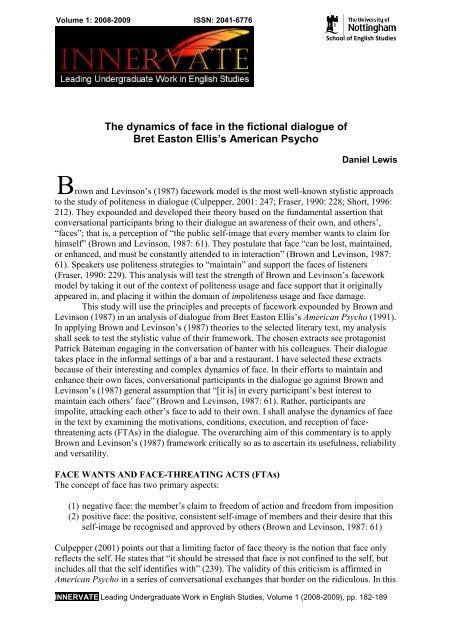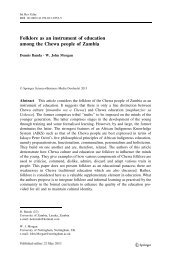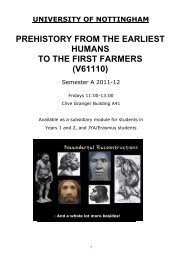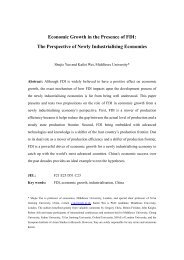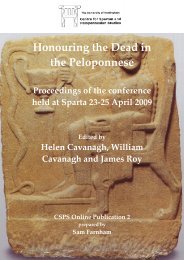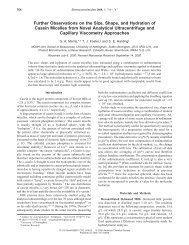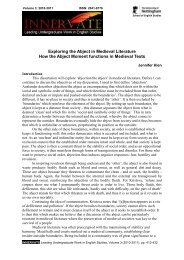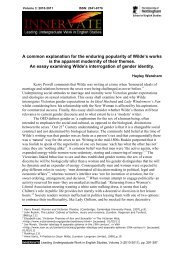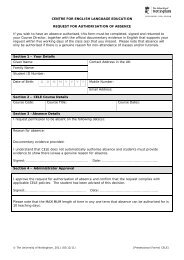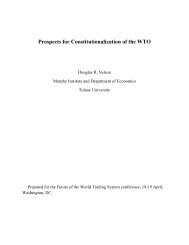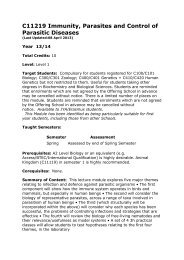The dynamics of face in the fictional dialogue of Bret Easton Ellis's ...
The dynamics of face in the fictional dialogue of Bret Easton Ellis's ...
The dynamics of face in the fictional dialogue of Bret Easton Ellis's ...
You also want an ePaper? Increase the reach of your titles
YUMPU automatically turns print PDFs into web optimized ePapers that Google loves.
Volume 1: 2008-2009 ISSN: 2041-6776<br />
School <strong>of</strong> English Studies<br />
B<br />
<strong>The</strong> <strong>dynamics</strong> <strong>of</strong> <strong>face</strong> <strong>in</strong> <strong>the</strong> <strong>fictional</strong> <strong>dialogue</strong> <strong>of</strong><br />
<strong>Bret</strong> <strong>Easton</strong> Ellis’s American Psycho<br />
Daniel Lewis<br />
rown and Lev<strong>in</strong>son‟s (1987) <strong>face</strong>work model is <strong>the</strong> most well-known stylistic approach<br />
to <strong>the</strong> study <strong>of</strong> politeness <strong>in</strong> <strong>dialogue</strong> (Culpepper, 2001: 247; Fraser, 1990: 228; Short, 1996:<br />
212). <strong>The</strong>y expounded and developed <strong>the</strong>ir <strong>the</strong>ory based on <strong>the</strong> fundamental assertion that<br />
conversational participants br<strong>in</strong>g to <strong>the</strong>ir <strong>dialogue</strong> an awareness <strong>of</strong> <strong>the</strong>ir own, and o<strong>the</strong>rs‟,<br />
“<strong>face</strong>s”; that is, a perception <strong>of</strong> “<strong>the</strong> public self-image that every member wants to claim for<br />
himself” (Brown and Lev<strong>in</strong>son, 1987: 61). <strong>The</strong>y postulate that <strong>face</strong> “can be lost, ma<strong>in</strong>ta<strong>in</strong>ed,<br />
or enhanced, and must be constantly attended to <strong>in</strong> <strong>in</strong>teraction” (Brown and Lev<strong>in</strong>son, 1987:<br />
61). Speakers use politeness strategies to “ma<strong>in</strong>ta<strong>in</strong>” and support <strong>the</strong> <strong>face</strong>s <strong>of</strong> listeners<br />
(Fraser, 1990: 229). This analysis will test <strong>the</strong> strength <strong>of</strong> Brown and Lev<strong>in</strong>son‟s <strong>face</strong>work<br />
model by tak<strong>in</strong>g it out <strong>of</strong> <strong>the</strong> context <strong>of</strong> politeness usage and <strong>face</strong> support that it orig<strong>in</strong>ally<br />
appeared <strong>in</strong>, and plac<strong>in</strong>g it with<strong>in</strong> <strong>the</strong> doma<strong>in</strong> <strong>of</strong> impoliteness usage and <strong>face</strong> damage.<br />
This study will use <strong>the</strong> pr<strong>in</strong>ciples and precepts <strong>of</strong> <strong>face</strong>work expounded by Brown and<br />
Lev<strong>in</strong>son (1987) <strong>in</strong> an analysis <strong>of</strong> <strong>dialogue</strong> from <strong>Bret</strong> <strong>Easton</strong> Ellis‟s American Psycho (1991).<br />
In apply<strong>in</strong>g Brown and Lev<strong>in</strong>son‟s (1987) <strong>the</strong>ories to <strong>the</strong> selected literary text, my analysis<br />
shall seek to test <strong>the</strong> stylistic value <strong>of</strong> <strong>the</strong>ir framework. <strong>The</strong> chosen extracts see protagonist<br />
Patrick Bateman engag<strong>in</strong>g <strong>in</strong> <strong>the</strong> conversation <strong>of</strong> banter with his colleagues. <strong>The</strong>ir <strong>dialogue</strong><br />
takes place <strong>in</strong> <strong>the</strong> <strong>in</strong>formal sett<strong>in</strong>gs <strong>of</strong> a bar and a restaurant. I have selected <strong>the</strong>se extracts<br />
because <strong>of</strong> <strong>the</strong>ir <strong>in</strong>terest<strong>in</strong>g and complex <strong>dynamics</strong> <strong>of</strong> <strong>face</strong>. In <strong>the</strong>ir efforts to ma<strong>in</strong>ta<strong>in</strong> and<br />
enhance <strong>the</strong>ir own <strong>face</strong>s, conversational participants <strong>in</strong> <strong>the</strong> <strong>dialogue</strong> go aga<strong>in</strong>st Brown and<br />
Lev<strong>in</strong>son‟s (1987) general assumption that “[it is] <strong>in</strong> every participant‟s best <strong>in</strong>terest to<br />
ma<strong>in</strong>ta<strong>in</strong> each o<strong>the</strong>rs‟ <strong>face</strong>” (Brown and Lev<strong>in</strong>son, 1987: 61). Ra<strong>the</strong>r, participants are<br />
impolite, attack<strong>in</strong>g each o<strong>the</strong>r‟s <strong>face</strong> to add to <strong>the</strong>ir own. I shall analyse <strong>the</strong> <strong>dynamics</strong> <strong>of</strong> <strong>face</strong><br />
<strong>in</strong> <strong>the</strong> text by exam<strong>in</strong><strong>in</strong>g <strong>the</strong> motivations, conditions, execution, and reception <strong>of</strong> <strong>face</strong>threaten<strong>in</strong>g<br />
acts (FTAs) <strong>in</strong> <strong>the</strong> <strong>dialogue</strong>. <strong>The</strong> overarch<strong>in</strong>g aim <strong>of</strong> this commentary is to apply<br />
Brown and Lev<strong>in</strong>son‟s (1987) framework critically so as to ascerta<strong>in</strong> its usefulness, reliability<br />
and versatility.<br />
FACE WANTS AND FACE-THREATING ACTS (FTAs)<br />
<strong>The</strong> concept <strong>of</strong> <strong>face</strong> has two primary aspects:<br />
(1) negative <strong>face</strong>: <strong>the</strong> member‟s claim to freedom <strong>of</strong> action and freedom from imposition<br />
(2) positive <strong>face</strong>: <strong>the</strong> positive, consistent self-image <strong>of</strong> members and <strong>the</strong>ir desire that this<br />
self-image be recognised and approved by o<strong>the</strong>rs (Brown and Lev<strong>in</strong>son, 1987: 61)<br />
Culpepper (2001) po<strong>in</strong>ts out that a limit<strong>in</strong>g factor <strong>of</strong> <strong>face</strong> <strong>the</strong>ory is <strong>the</strong> notion that <strong>face</strong> only<br />
reflects <strong>the</strong> self. He states that “it should be stressed that <strong>face</strong> is not conf<strong>in</strong>ed to <strong>the</strong> self, but<br />
<strong>in</strong>cludes all that <strong>the</strong> self identifies with” (239). <strong>The</strong> validity <strong>of</strong> this criticism is affirmed <strong>in</strong><br />
American Psycho <strong>in</strong> a series <strong>of</strong> conversational exchanges that border on <strong>the</strong> ridiculous. In this<br />
INNERVATE Lead<strong>in</strong>g Undergraduate Work <strong>in</strong> English Studies, Volume 1 (2008-2009), pp. 182-189
Daniel Lewis 183<br />
segment, <strong>the</strong> vanity <strong>of</strong> <strong>the</strong> characters is demonstrated as <strong>the</strong>y compare <strong>the</strong> colour<strong>in</strong>gs,<br />
letter<strong>in</strong>gs and textures <strong>of</strong> <strong>the</strong>ir respective bus<strong>in</strong>ess cards. Upon present<strong>in</strong>g his card to <strong>the</strong><br />
group, Bateman‟s first person narrative reads, “I try to act casual about it but I‟m smil<strong>in</strong>g<br />
proudly” (Ellis, 1991: 42). Bateman‟s proud regard <strong>of</strong> his bus<strong>in</strong>ess card suggests his<br />
conviction that he is a man <strong>of</strong> ref<strong>in</strong>ed taste. <strong>The</strong> object is <strong>the</strong>refore l<strong>in</strong>ked to his positive <strong>face</strong>.<br />
Confident <strong>in</strong> <strong>the</strong> aes<strong>the</strong>tic beauty <strong>of</strong> his card, Bateman seeks gratification <strong>of</strong> his positive <strong>face</strong><br />
by ask<strong>in</strong>g, “What do you th<strong>in</strong>k?” (Ellis, 1991: 42). This backfires on him, however, and he is<br />
left feel<strong>in</strong>g dejected when confronted with <strong>the</strong> more impressive fonts and textures <strong>of</strong> <strong>the</strong><br />
o<strong>the</strong>rs‟ cards: “I am unexpectedly depressed that I started this” (Ellis, 1990: 43). Brown and<br />
Lev<strong>in</strong>son (1987) claim that “<strong>face</strong> is someth<strong>in</strong>g that is emotionally <strong>in</strong>vested” (61). Based on<br />
this supposition and <strong>the</strong> evidence above, it should be understood that anyth<strong>in</strong>g which one<br />
emotionally <strong>in</strong>vests <strong>in</strong> – even if it is external to one‟s self – is part <strong>of</strong> one‟s <strong>face</strong>.<br />
In conversation, <strong>face</strong> wants arise from <strong>the</strong> two primary aspects <strong>of</strong> <strong>face</strong>.<br />
Correspond<strong>in</strong>gly, negative <strong>face</strong> wants reflect <strong>the</strong> desire <strong>of</strong> freedom from imposition, while<br />
positive <strong>face</strong> wants <strong>in</strong>clude <strong>the</strong> desire to have one‟s identity “ratified, understood, approved<br />
<strong>of</strong>, liked or admired” (Brown and Lev<strong>in</strong>son 1987: 62). Culpepper (2001) expla<strong>in</strong>s, ”Any<br />
action that imp<strong>in</strong>ges <strong>in</strong> some degree upon a person‟s <strong>face</strong> (typically, orders, <strong>in</strong>sults,<br />
criticisms) is a „<strong>face</strong>-threaten<strong>in</strong>g act‟” (239). FTAs can be issued un<strong>in</strong>tentionally. When <strong>face</strong><br />
damage is <strong>in</strong>tended, however, it is enacted through impoliteness super-strategies. Culpepper<br />
(1996) identifies <strong>the</strong> follow<strong>in</strong>g as impoliteness super-strategies:<br />
(1) Bald, on-record impoliteness - <strong>the</strong> FTA is performed <strong>in</strong> a direct, clear, unambiguous<br />
and concise way <strong>in</strong> circumstances where <strong>face</strong> is not irrelevant or m<strong>in</strong>imised.<br />
(2) Positive impoliteness – <strong>The</strong> use <strong>of</strong> strategies designed to damage <strong>the</strong> addressee‟s<br />
positive <strong>face</strong> wants.<br />
(3) Negative impoliteness – <strong>The</strong> use <strong>of</strong> strategies designed to damage <strong>the</strong> addressee‟s<br />
negative <strong>face</strong> wants.<br />
(4) Sarcasm or mock politeness - <strong>the</strong> FTA is performed with <strong>the</strong> use <strong>of</strong> politeness<br />
strategies that are obviously <strong>in</strong>s<strong>in</strong>cere.<br />
(5) Withhold politeness - <strong>the</strong> absence <strong>of</strong> politeness work where it would be expected.<br />
(summarized; 356-357)<br />
Examples <strong>of</strong> <strong>face</strong>-threaten<strong>in</strong>g acts (FTAs) executed via <strong>the</strong> use <strong>of</strong> all <strong>of</strong> <strong>the</strong>se impoliteness<br />
super-strategies can be seen <strong>in</strong> <strong>the</strong> utterances made by Price below:<br />
“Oh wait, guys, listen, I got a joke.” Preston rubs his hands toge<strong>the</strong>r.<br />
“Preston,” Price says, “you are a joke. You do know you weren’t <strong>in</strong>vited to d<strong>in</strong>ner.<br />
By <strong>the</strong> way, nice jacket; nonmatch<strong>in</strong>g but complementary.” (Ellis, 1991: 36)<br />
Preston displays his want <strong>of</strong> <strong>in</strong>clusion <strong>in</strong> <strong>the</strong> group by approach<strong>in</strong>g <strong>the</strong> party, participat<strong>in</strong>g <strong>in</strong><br />
<strong>the</strong>ir conversation, and referr<strong>in</strong>g to <strong>the</strong>m with <strong>the</strong> <strong>in</strong>formal collective noun “guys”, which has<br />
connotations <strong>of</strong> equality and friendl<strong>in</strong>ess. Price rebuffs this <strong>face</strong> want with negative<br />
impoliteness by imply<strong>in</strong>g that Preston has no right to jo<strong>in</strong> <strong>the</strong> “guys” for d<strong>in</strong>ner. Fur<strong>the</strong>rmore,<br />
by <strong>in</strong>terject<strong>in</strong>g <strong>in</strong> <strong>the</strong> moment when Preston is about to tell his joke, Price withholds<br />
politeness. This act also impedes on Preston‟s right to speak and be heard, and is thus<br />
negative impoliteness.<br />
Culpepper (2001) states, “<strong>The</strong> want to be liked lies at <strong>the</strong> heart <strong>of</strong> positive <strong>face</strong><br />
concerns” (253). Price uses multiple acts <strong>of</strong> positive impoliteness aga<strong>in</strong>st Preston <strong>in</strong> a display<br />
that ultimately attests to his personal dislike for Price. <strong>The</strong> first positive FTA presents itself <strong>in</strong><br />
<strong>the</strong> <strong>in</strong>s<strong>in</strong>uation that Preston does not warrant <strong>the</strong> respect <strong>of</strong> be<strong>in</strong>g taken seriously: “you are a<br />
INNERVATE Lead<strong>in</strong>g Undergraduate Work <strong>in</strong> English Studies, Volume 1 (2008-2009), pp. 182-189
184 <strong>The</strong> <strong>dynamics</strong> <strong>of</strong> <strong>face</strong> <strong>in</strong> <strong>the</strong> <strong>fictional</strong> <strong>dialogue</strong> <strong>of</strong> <strong>Bret</strong> <strong>Easton</strong> Ellis’s American Psycho<br />
joke”. This is a bald, on-record FTA as it is an <strong>in</strong>sult that appears <strong>in</strong> declarative form. <strong>The</strong>re<br />
is also an <strong>of</strong>f-record, mock politeness attack on Preston‟s positive <strong>face</strong> <strong>in</strong> <strong>the</strong> f<strong>in</strong>al utterances<br />
<strong>of</strong> Price‟s <strong>dialogue</strong>. <strong>The</strong> <strong>face</strong>-enhanc<strong>in</strong>g remarks “nice jacket” and “[it‟s] complementary” are<br />
rendered <strong>in</strong>s<strong>in</strong>cere by <strong>the</strong> observation, embedded <strong>in</strong> <strong>the</strong> compliments, that Preston‟s suit is<br />
“nonmatch<strong>in</strong>g”. Attire receives an <strong>in</strong>ord<strong>in</strong>ate amount <strong>of</strong> scrut<strong>in</strong>y <strong>in</strong> <strong>the</strong> men‟s preced<strong>in</strong>g<br />
<strong>dialogue</strong> (what one should wear; how one should wear it). Draw<strong>in</strong>g attention to Preston‟s<br />
failure to comply with a fundamental rule <strong>of</strong> fashion (that garments should match) can thus<br />
be seen to be a personal slight. <strong>The</strong> sarcasm latent <strong>in</strong> this veiled, yet apparent, attack<br />
complements <strong>the</strong> sentiment <strong>of</strong> <strong>the</strong> orig<strong>in</strong>al positive FTA, emphasis<strong>in</strong>g that Preston is <strong>in</strong>deed<br />
“a joke”.<br />
<strong>The</strong> statement “You do know you weren’t <strong>in</strong>vited to d<strong>in</strong>ner” – which, as established<br />
above, constitutes a negative FTA – could also be read as a positive FTA as it suggests that<br />
Preston‟s company is not desirable. As Culpepper, Bousfield and Wichmann (2003) note, “A<br />
particular problem we <strong>in</strong>herited from Brown and Lev<strong>in</strong>son (1987)…is <strong>the</strong> dist<strong>in</strong>ction between<br />
both positive and negative <strong>face</strong>” (1576). Brown and Lev<strong>in</strong>son (1987) propose, “We may<br />
make a…dist<strong>in</strong>ction between acts that threaten negative <strong>face</strong> and those that threaten positive<br />
<strong>face</strong>” (65). This suggests that negative and positive FTAs are mutually exclusive. This is an<br />
area <strong>of</strong> weakness <strong>in</strong> <strong>the</strong>ir framework that requires revision. It must be acknowledged that<br />
FTAs can be motivated by multiple purposes and achieve multiple effects, and may <strong>the</strong>refore<br />
threaten both negative and positive <strong>face</strong>s simultaneously.<br />
SOCIOLOGICAL VARIABLES AND MEASURING FACE THREATS<br />
Short (1996) posits that <strong>in</strong> addition to perform<strong>in</strong>g FTAs on-record and without redress,<br />
impoliteness may be demonstrated by maximis<strong>in</strong>g “<strong>the</strong> number and size <strong>of</strong> your FTAs” (214).<br />
Assum<strong>in</strong>g that Short (1996) uses “size” to refer to <strong>the</strong> degree <strong>of</strong> threat posed, how does <strong>the</strong><br />
speaker anticipate <strong>the</strong> “size” <strong>of</strong> <strong>the</strong> FTA he/she is to deliver? How does <strong>the</strong> listener <strong>in</strong>terpret<br />
<strong>the</strong> “size” <strong>of</strong> received FTAs? <strong>The</strong> measurement <strong>of</strong> <strong>face</strong> threats is <strong>in</strong>tegral to how speakers<br />
choose to present FTAs and how <strong>the</strong>ir listeners choose to respond to <strong>the</strong>m. Brown and<br />
Lev<strong>in</strong>son (1987) claim that <strong>the</strong> “seriousness <strong>of</strong> an FTA (that is, <strong>the</strong> calculations that members<br />
actually seem to make)” depends upon three “sociological variables”:<br />
(i) <strong>the</strong> social distance/proximity <strong>of</strong> <strong>the</strong> speaker and listener<br />
(ii) <strong>the</strong> relative power dynamic shared by <strong>the</strong> speaker and listener<br />
(iii)<strong>the</strong> absolute rank<strong>in</strong>g <strong>of</strong> <strong>the</strong> imposition(s) performed on <strong>the</strong> listener‟s <strong>face</strong> wants <strong>in</strong> <strong>the</strong><br />
particular culture and situation <strong>in</strong> which <strong>the</strong> FTA takes place (summarised; 74)<br />
<strong>The</strong> first two variables are problematic as <strong>the</strong>y do not fully account for <strong>the</strong> complexity and<br />
volatility <strong>of</strong> contextual, situational and subjective conditions, and <strong>the</strong>ir ability to alter social<br />
distance and relative power <strong>dynamics</strong>. Simpson (2002) asserts that <strong>the</strong> “most<br />
significant…[<strong>of</strong>] basic assumptions about <strong>the</strong> communication properties <strong>of</strong> language <strong>in</strong><br />
general and about <strong>the</strong> nature <strong>of</strong> spoken <strong>in</strong>teraction…is that all <strong>in</strong>teraction occurs <strong>in</strong> a context”<br />
(37). In contrast to <strong>the</strong> o<strong>the</strong>r two, <strong>the</strong> third variable benefits from <strong>the</strong> acknowledgement that<br />
<strong>the</strong> rank<strong>in</strong>g <strong>of</strong> various impositions depends on <strong>the</strong> particular culture and situation <strong>in</strong> which<br />
<strong>the</strong>y arise. For example, <strong>in</strong>dividuals who enter <strong>the</strong> sett<strong>in</strong>g <strong>of</strong> a restaurant enter <strong>in</strong>to <strong>the</strong><br />
agreement that <strong>the</strong> customer/employee relationship assumes a boss/server dialectic. It is<br />
<strong>the</strong>refore socially acceptable for Price to deliver <strong>the</strong> imperative “Just take <strong>the</strong>m all” to <strong>the</strong><br />
waiter who he wishes to take <strong>the</strong> party‟s dr<strong>in</strong>ks away. In <strong>the</strong> physical context <strong>of</strong> <strong>the</strong><br />
restaurant, such commands do not constitute strong negative <strong>face</strong> threats because staff and<br />
customers are <strong>in</strong> agreement that wait<strong>in</strong>g staff are subservient. Similarly, Bateman‟s brib<strong>in</strong>g a<br />
waitress so that he and his friends may smoke cigars creates a context <strong>of</strong> transaction.<br />
INNERVATE Lead<strong>in</strong>g Undergraduate Work <strong>in</strong> English Studies, Volume 1 (2008-2009), pp. 182-189
Daniel Lewis 185<br />
Bateman‟s payment for a service is accepted, and so <strong>the</strong> waitress is expected to provide it.<br />
Bateman‟s bald, on-record command “if anyone compla<strong>in</strong>s, well… Kick „em out” (Ellis,<br />
1991: 45) does <strong>the</strong>refore not signify a significant FTA.<br />
I, <strong>the</strong>refore, have no significant misgiv<strong>in</strong>gs with <strong>the</strong> analytical variable <strong>of</strong> absolute<br />
rank<strong>in</strong>g <strong>of</strong> impositions <strong>in</strong> <strong>the</strong> context <strong>in</strong> which <strong>the</strong>y appear. I would perhaps, however, seek to<br />
improve it by add<strong>in</strong>g <strong>the</strong> important factor <strong>of</strong> <strong>the</strong> particular subjectivities <strong>of</strong> both speaker and<br />
listener. I shall elaborate on this factor <strong>in</strong> discuss<strong>in</strong>g <strong>the</strong> o<strong>the</strong>r two variables. In determ<strong>in</strong><strong>in</strong>g<br />
<strong>the</strong> “seriousness” <strong>of</strong> a <strong>face</strong> threat, <strong>the</strong> variables <strong>of</strong> social distance and relative power should<br />
likewise be exam<strong>in</strong>ed with significant regard to <strong>the</strong>ir sensitivity to contextual and situational<br />
conditions. I shall demonstrate this by apply<strong>in</strong>g each <strong>of</strong> <strong>the</strong> two variables to <strong>dialogue</strong> from <strong>the</strong><br />
selected text.<br />
(i) social distance/proximity – Brown and Lev<strong>in</strong>son (1987) claim that<br />
“<strong>the</strong> reciprocal giv<strong>in</strong>g and receiv<strong>in</strong>g <strong>of</strong> positive <strong>face</strong> is symptomatic <strong>of</strong> social closeness” (74).<br />
Conversational participants who share a close social distance may also, however, perform<br />
“mock” positive FTAs – that is, pretend to attack listeners‟ positive <strong>face</strong>s – <strong>in</strong> a spirit <strong>of</strong><br />
playfulness. Culpepper (2001) remarks that “[a speaker] might use mock impoliteness<br />
(banter), perhaps to re<strong>in</strong>force social solidarity” (246). Banter, <strong>the</strong>n, can be seen to be a<br />
strategy <strong>in</strong> which FTAs are performed with humorous (ra<strong>the</strong>r than harmful) <strong>in</strong>tent <strong>in</strong> order to<br />
decrease social distance/<strong>in</strong>crease social proximity. It is an <strong>in</strong>vitation to a conversational<br />
game, and can <strong>the</strong>refore complement <strong>the</strong> listener‟s positive <strong>face</strong> by suggest<strong>in</strong>g <strong>the</strong> perception<br />
that <strong>the</strong> listener is fun and that <strong>the</strong> listener‟s company <strong>in</strong> play is desirable. This is not to say<br />
that harm cannot be an effect <strong>of</strong> banter, however. Take <strong>the</strong> follow<strong>in</strong>g:<br />
Outside Pastels a different bum sits <strong>in</strong> <strong>the</strong> street […]<br />
“That dude needs a facial real bad,” I say.<br />
“Hey McDermott,” Price cackles. “Throw him your tie.”<br />
“Oh shit. What‟s that gonna get him?” I ask, star<strong>in</strong>g at <strong>the</strong> bum.<br />
“Appetizers at Jams.” Van Patten laughs. He gives me high-five.<br />
“Dude,” McDermott says, <strong>in</strong>spect<strong>in</strong>g his tie, clearly <strong>of</strong>fended.<br />
(Ellis, 1991: 49)<br />
Here, McDermott‟s positive <strong>face</strong> is victimised by <strong>the</strong> positive FTAs made aga<strong>in</strong>st his tie.<br />
Each <strong>of</strong> <strong>the</strong> o<strong>the</strong>r men contributes a positive FTA on McDermott. Social solidarity is <strong>in</strong>deed<br />
achieved, as <strong>in</strong>dicated by Van Patten‟s “high-five” gesture. Solidarity with <strong>the</strong> target <strong>of</strong> <strong>the</strong><br />
FTAs is not achieved, however, as McDermott is “clearly <strong>of</strong>fended”. His positive <strong>face</strong> has<br />
been damaged by <strong>the</strong> criticisms aimed at his tie.<br />
Follow<strong>in</strong>g Brown and Lev<strong>in</strong>son‟s (1987) model unquestion<strong>in</strong>gly may result <strong>in</strong> a<br />
read<strong>in</strong>g <strong>of</strong> <strong>the</strong> extract that views such FTAs exchanged between <strong>the</strong> characters as a playful<br />
reflection <strong>of</strong> <strong>the</strong>ir social closeness. When tak<strong>in</strong>g <strong>in</strong>to consideration <strong>the</strong> actual threat posed by<br />
an FTA, however, one must also consider <strong>the</strong> follow<strong>in</strong>g contextual and situational factors:<br />
(1) Participants‟ cultures external to <strong>the</strong> immediate conversational situation. <strong>The</strong><br />
conversational participants <strong>in</strong> <strong>the</strong> text are all Wall Street bankers. As has been established,<br />
<strong>face</strong> <strong>in</strong>cludes that which <strong>the</strong> self identifies with and so one‟s work may factor <strong>in</strong>to one‟s <strong>face</strong><br />
motivations, even outside that environment. Participat<strong>in</strong>g <strong>in</strong> a highly competitive bus<strong>in</strong>ess<br />
culture may motivate “serious” FTAs <strong>in</strong> order to complement one‟s own negative and<br />
positive <strong>face</strong>s by achiev<strong>in</strong>g a sense <strong>of</strong> power; power be<strong>in</strong>g a valuable, yet vulnerable<br />
commodity <strong>in</strong> bus<strong>in</strong>ess.<br />
(2) Participants‟ relationships external to <strong>the</strong> immediate conversational situation.<br />
In <strong>the</strong> <strong>dialogue</strong> from <strong>the</strong> extract, participants share jokes, op<strong>in</strong>ions and knowledge, seem<strong>in</strong>g<br />
to demonstrate jovial, close relationships with one ano<strong>the</strong>r. It should also be noted, however,<br />
INNERVATE Lead<strong>in</strong>g Undergraduate Work <strong>in</strong> English Studies, Volume 1 (2008-2009), pp. 182-189
186 <strong>The</strong> <strong>dynamics</strong> <strong>of</strong> <strong>face</strong> <strong>in</strong> <strong>the</strong> <strong>fictional</strong> <strong>dialogue</strong> <strong>of</strong> <strong>Bret</strong> <strong>Easton</strong> Ellis’s American Psycho<br />
that <strong>the</strong>se men are all equal colleagues at <strong>the</strong> same company. Connected with <strong>the</strong> importance<br />
<strong>of</strong> <strong>the</strong>ir shared culture, an element <strong>of</strong> competition may undercut <strong>the</strong> men‟s relationships with<br />
one ano<strong>the</strong>r, even <strong>in</strong> <strong>in</strong>formal sett<strong>in</strong>gs and situations.<br />
(3) <strong>The</strong> respective subjectivities <strong>of</strong> <strong>the</strong> FTA performer and <strong>the</strong> FTA target. As<br />
evidenced <strong>in</strong> <strong>the</strong> example above, an FTA can be construed as threaten<strong>in</strong>g even when <strong>the</strong><br />
<strong>in</strong>tent with which it is delivered may not be malicious. <strong>The</strong> dist<strong>in</strong>ction between illocutionary<br />
force and perlocutionary effect is helpful <strong>in</strong> identify<strong>in</strong>g such differences. Short (1996) notes<br />
that <strong>the</strong> illocutionary force is <strong>the</strong> “[a]ct performed by speak<strong>in</strong>g” while <strong>the</strong> perlocutionary<br />
effect is <strong>the</strong> “[a]ctual effect caused by <strong>the</strong> act” (197). While <strong>the</strong> illocutionary forces delivered<br />
by Price, Bateman and Van Patten <strong>in</strong> criticis<strong>in</strong>g McDermott‟s tie may appear to be mock<br />
FTAs (banter) that reflect social proximity, <strong>the</strong>ir perlocutionary effect is <strong>in</strong>sult, as McDermott<br />
is left “clearly <strong>of</strong>fended” (Ellis, 1991: 49). If one is to attempt to measure an FTA one must<br />
consider <strong>the</strong> subjective contexts <strong>in</strong> which it is delivered and received, for <strong>face</strong> is ultimately a<br />
subjective entity. This is conducive to reach<strong>in</strong>g greater understand<strong>in</strong>gs <strong>of</strong> <strong>the</strong> operative<br />
motivations and relational <strong>dynamics</strong> <strong>in</strong> conversations. <strong>The</strong> discrepancy between <strong>the</strong><br />
illocutionary force and <strong>the</strong> actual perlocutionary effect <strong>of</strong> <strong>the</strong> FTA aga<strong>in</strong>st McDermott<br />
illustrates that, despite <strong>the</strong> seem<strong>in</strong>g banter <strong>of</strong> <strong>the</strong> men‟s illocutionary forces, <strong>face</strong> is <strong>in</strong>deed<br />
vulnerable to damage <strong>in</strong> <strong>the</strong>ir company.<br />
<strong>The</strong> contextual considerations <strong>of</strong> (1) and (2), and <strong>the</strong> situational consideration <strong>of</strong> (3),<br />
suggest that <strong>the</strong>re is a wider social distance between <strong>the</strong> men than may <strong>in</strong>itially seem apparent<br />
<strong>in</strong> <strong>the</strong> <strong>dialogue</strong>‟s banter. For, <strong>in</strong> light <strong>of</strong> <strong>the</strong> exam<strong>in</strong>ation <strong>of</strong> <strong>the</strong>se factors, it may be observed<br />
<strong>the</strong> men assume competitive roles <strong>in</strong> <strong>the</strong>ir conversation with each o<strong>the</strong>r. Perform<strong>in</strong>g bald<br />
FTAs aga<strong>in</strong>st conversational participants seen as competitors functions to enhance speakers‟<br />
own <strong>face</strong>s: negative <strong>face</strong> is added to by virtue <strong>of</strong> realis<strong>in</strong>g one‟s potential to beat <strong>the</strong><br />
competition; positive <strong>face</strong> is added to <strong>in</strong> its asymmetrical alignment with <strong>the</strong> competitor‟s<br />
damaged <strong>face</strong>; and FTAs that are met with <strong>the</strong> support <strong>of</strong> o<strong>the</strong>rs (as above) naturally gratify<br />
<strong>the</strong> positive <strong>face</strong> want <strong>of</strong> approval. Insights <strong>of</strong> <strong>face</strong> <strong>in</strong> <strong>in</strong>teraction may also be reached by<br />
apply<strong>in</strong>g <strong>the</strong> contextual and situational factors expounded above to <strong>the</strong> sociological variable<br />
<strong>of</strong> <strong>the</strong> relative power dynamic:<br />
(ii) relative power dynamic – While <strong>the</strong> bus<strong>in</strong>essmen are wait<strong>in</strong>g for <strong>the</strong>ir<br />
appetisers to arrive, Scott Montgomery, an acqua<strong>in</strong>tance <strong>of</strong> <strong>the</strong>irs, enters <strong>the</strong> restaurant. Van<br />
Patten notices this and entices his fellow d<strong>in</strong>ers to guess whom he has spotted. Van Patten<br />
h<strong>in</strong>ts, “He‟s twenty-four and worth, oh, let‟s say a repulsive amount <strong>of</strong> dough… A veritable<br />
shitload” (Ellis, 1991: 39). Despite exhibit<strong>in</strong>g positive impoliteness aga<strong>in</strong>st Montgomery <strong>in</strong><br />
his absence (“It‟s that dwarf”; “Watch me act thrilled. Well, as thrilled as I can get meet<strong>in</strong>g<br />
someone from Georgia” (Ellis, 1991: 40)), Price demonstrates positive politeness when<br />
Montgomery approaches <strong>the</strong>ir table:<br />
“Montgomery,” Price says <strong>in</strong> a k<strong>in</strong>dly, conversational tone […] “How have th<strong>in</strong>gs<br />
been?”<br />
“Well, fellas,” Montgomery says. “See y‟all got <strong>the</strong> primo table. Get <strong>the</strong> check yet?<br />
Just kidd<strong>in</strong>g.”<br />
“Listen, Montgomery,” Price says […] be<strong>in</strong>g unusually k<strong>in</strong>d to someone I thought<br />
was a stranger. “Squash?”<br />
“Call me,” Montgomery says absently, look<strong>in</strong>g over <strong>the</strong> room. “Is that Tyson? Here‟s<br />
my card.”<br />
“Great,” Price says, pocket<strong>in</strong>g it. “Thursday?”<br />
“Can‟t. Go<strong>in</strong>g to Dallas tomorrow, but…” Montgomery is already mov<strong>in</strong>g away from<br />
<strong>the</strong> table, hurry<strong>in</strong>g toward someone else […] “Yeah, next week.” (Ellis, 1991: 40)<br />
INNERVATE Lead<strong>in</strong>g Undergraduate Work <strong>in</strong> English Studies, Volume 1 (2008-2009), pp. 182-189
Daniel Lewis 187<br />
<strong>The</strong> degree <strong>of</strong> threat to <strong>face</strong> <strong>in</strong> this passage cannot be reliably ascerta<strong>in</strong>ed without prob<strong>in</strong>g <strong>the</strong><br />
cultural, relational and subjective conditions <strong>of</strong> power between Montgomery and Price. <strong>The</strong><br />
fact that Montgomery is worth “a veritable shitload” <strong>of</strong> money <strong>in</strong>dicates his superior success<br />
and <strong>in</strong>fluence <strong>in</strong> <strong>the</strong> Wall Street bank<strong>in</strong>g culture. Price‟s friendly positive politeness, despite<br />
Montgomery‟s status as a “stranger” and Price‟s supposed low op<strong>in</strong>ion <strong>of</strong> him, demonstrates<br />
an attempt to redress <strong>the</strong> power imbalance between <strong>the</strong>m. Montgomery ma<strong>in</strong>ta<strong>in</strong>s his upper<br />
hand <strong>in</strong> this imbalance by ignor<strong>in</strong>g Price‟s question “How have th<strong>in</strong>gs been?”. This is a<br />
demonstration <strong>of</strong> <strong>the</strong> impoliteness super-strategy <strong>of</strong> withhold<strong>in</strong>g politeness: “Keep[<strong>in</strong>g] silent<br />
or fail[<strong>in</strong>g] to act where politeness work is necessary” (Culpepper, Bousfield and Wichmann,<br />
2003: 1555). Montgomery‟s status and his impoliteness choice attest to Culpepper‟s (2001)<br />
assertion that “<strong>the</strong> more powerful speaker [is] associated with less politeness” (241).<br />
Montgomery cont<strong>in</strong>ues to attack Price‟s <strong>face</strong> by deflect<strong>in</strong>g Price‟s request to play<br />
squash with him. This po<strong>in</strong>ts to Montgomery‟s refusal to establish an equal relationship<br />
between <strong>the</strong> pair, which is also implied by <strong>the</strong> bus<strong>in</strong>esslike gesture <strong>of</strong> giv<strong>in</strong>g Price his contact<br />
card. By refus<strong>in</strong>g rights to equal friendship, Montgomery denies Price‟s negative <strong>face</strong> want <strong>of</strong><br />
social mobility and <strong>the</strong> possible positive <strong>face</strong> want <strong>of</strong> achiev<strong>in</strong>g <strong>in</strong>fluence through association<br />
with <strong>the</strong> powerful Montgomery. Fur<strong>the</strong>rmore, Price‟s negative and/or positive <strong>face</strong> want <strong>of</strong><br />
receiv<strong>in</strong>g <strong>the</strong> full attention <strong>of</strong> his addressee <strong>in</strong> conversation is denied. Montgomery‟s<br />
participation <strong>in</strong> <strong>the</strong> conversation is distracted by <strong>the</strong> observation <strong>of</strong> ano<strong>the</strong>r d<strong>in</strong>er (“Is that<br />
Tyson?”), and he departs <strong>the</strong> conversation before it has reached polite closure. Ano<strong>the</strong>r effect<br />
<strong>of</strong> Montgomery‟s <strong>in</strong>attentiveness is positive <strong>face</strong> damage, as it suggests that Price is not liked<br />
by Montgomery; perhaps not disliked, per se, but not liked none<strong>the</strong>less.<br />
<strong>The</strong> seriousness <strong>of</strong> <strong>the</strong> threats <strong>in</strong> this <strong>in</strong>teraction may be observed from <strong>the</strong> subjective<br />
affects <strong>the</strong>y appear to have on Price. When McDermott reiterates how much Montgomery is<br />
worth, Price virulently retorts, “Go over and give <strong>the</strong> dwarf head – will that shut you up?”<br />
(Ellis, 1991: 41). This utterance displays impolite super-strategies <strong>of</strong> both positive and<br />
negative politeness; FTAs that attack:<br />
(a) Montgomery‟s positive <strong>face</strong> by referr<strong>in</strong>g to him as a “dwarf”. Montgomery is absent<br />
dur<strong>in</strong>g <strong>the</strong> delivery <strong>of</strong> <strong>the</strong> utterance, but it still constitutes an FTA as it denigrates his<br />
public self-image (his <strong>face</strong>).<br />
(b) McDermott‟s positive <strong>face</strong> by imply<strong>in</strong>g that McDermott has a homosexual desire for<br />
Montgomery. This can be seen to be a slight <strong>in</strong> <strong>the</strong> context <strong>of</strong> this conversation based<br />
<strong>the</strong> evidence that, prior to this juncture, Bateman replied defensively to <strong>the</strong><br />
implication that he was a homosexual by qualify<strong>in</strong>g his heterosexuality with<br />
hyperbole, “Ask Meredith if I‟m a homosexual. That is, if she‟ll take <strong>the</strong> time to pull<br />
my dick out <strong>of</strong> her mouth” (Ellis, 1991: 36).<br />
(c) McDermott‟s negative <strong>face</strong> by deliver<strong>in</strong>g <strong>the</strong> <strong>in</strong>sult as a command and imply<strong>in</strong>g that<br />
he should stop talk<strong>in</strong>g.<br />
<strong>The</strong>se multiple FTAs <strong>in</strong>dicate <strong>the</strong> loss <strong>of</strong> <strong>face</strong> that Price has experienced, as <strong>the</strong>y are triggered<br />
by <strong>the</strong> very quality that led to Price himself be<strong>in</strong>g <strong>the</strong> victim <strong>of</strong> Montgomery‟s FTAs: awe <strong>of</strong><br />
Montgomery‟s wealth and power. Price exhibits a “tit for tat” mentality; compensat<strong>in</strong>g for <strong>the</strong><br />
damage to his own <strong>face</strong> by damag<strong>in</strong>g <strong>the</strong> <strong>face</strong> <strong>of</strong> ano<strong>the</strong>r. Without provocation Price<br />
<strong>in</strong>terjects later <strong>in</strong> <strong>the</strong> <strong>dialogue</strong>, “Did I forget to tell everyone that Montgomery‟s a dwarf?”<br />
(Ellis, 1991: 44). Break<strong>in</strong>g <strong>the</strong> maxim <strong>of</strong> conversational relevance (Grice, 1975: 47), this<br />
superfluous attack on Montgomery‟s positive <strong>face</strong> also alludes to <strong>the</strong> severity <strong>of</strong><br />
Montgomery‟s FTAs. <strong>The</strong> last<strong>in</strong>g <strong>in</strong>flictions <strong>of</strong> <strong>face</strong> damage on Price are <strong>in</strong>dicated by his<br />
last<strong>in</strong>g perception that Montgomery‟s disempower<strong>in</strong>g FTAs warrant compensation through<br />
attack<strong>in</strong>g Montgomery‟s positive <strong>face</strong> <strong>in</strong> his absence.<br />
INNERVATE Lead<strong>in</strong>g Undergraduate Work <strong>in</strong> English Studies, Volume 1 (2008-2009), pp. 182-189
188 <strong>The</strong> <strong>dynamics</strong> <strong>of</strong> <strong>face</strong> <strong>in</strong> <strong>the</strong> <strong>fictional</strong> <strong>dialogue</strong> <strong>of</strong> <strong>Bret</strong> <strong>Easton</strong> Ellis’s American Psycho<br />
Fraser (1990) summarises <strong>the</strong> weakness <strong>of</strong> Brown and Lev<strong>in</strong>son‟s (1987) assumption<br />
that FTAs may be measured through <strong>the</strong> social distance and relative power <strong>of</strong> <strong>the</strong> speaker and<br />
listener, and <strong>the</strong> imposition rank<strong>in</strong>g <strong>of</strong> <strong>the</strong> FTA, by observ<strong>in</strong>g that “participants vacillate <strong>in</strong><br />
<strong>the</strong>ir social distance…[and] relative power is altered as <strong>the</strong> roles and responsibilities change<br />
back and forth even over short periods <strong>of</strong> time” (231).<br />
<strong>The</strong> sociological variables that Brown and Lev<strong>in</strong>son (1987) call upon to measure<br />
FTAs are subject to shifts along an <strong>in</strong>f<strong>in</strong>ite scale that fluctuates between m<strong>in</strong>or and<br />
transformative alterations. Conversational analysis cannot, <strong>the</strong>refore, depend on <strong>the</strong>se factors<br />
alone <strong>in</strong> seek<strong>in</strong>g to reach reliably <strong>in</strong>sightful conclusions. My analysis has attempted to show<br />
that reliable and valuable <strong>in</strong>sights regard<strong>in</strong>g FTAs are atta<strong>in</strong>able by complement<strong>in</strong>g Brown<br />
and Lev<strong>in</strong>son‟s (1987) sociological variables with read<strong>in</strong>gs <strong>of</strong> <strong>the</strong> contextual, situational and<br />
subjective conditions surround<strong>in</strong>g FTAs.<br />
CONCLUSION<br />
Follow<strong>in</strong>g on from <strong>the</strong> previous section, I would like to propose add<strong>in</strong>g to Brown and<br />
Lev<strong>in</strong>son‟s (1987) three aspects for analys<strong>in</strong>g <strong>face</strong> threats a fourth area:<br />
(iii)<strong>the</strong> unique contextual, situational and subjective backgrounds aga<strong>in</strong>st which <strong>the</strong> FTA<br />
is performed and received<br />
By acknowledg<strong>in</strong>g <strong>the</strong>se factors alongside <strong>the</strong> o<strong>the</strong>r sociological variables, <strong>the</strong> analyst and <strong>the</strong><br />
stylistician are much better placed to measure threats to <strong>face</strong> <strong>in</strong> terms <strong>of</strong> <strong>the</strong> <strong>in</strong>tent <strong>of</strong><br />
performers and <strong>the</strong> reception <strong>of</strong> targets. Such a rigorous method is particularly useful <strong>in</strong><br />
conversation where <strong>the</strong> <strong>dynamics</strong> <strong>of</strong> <strong>face</strong> are ambiguous. This has been demonstrated by<br />
analys<strong>in</strong>g <strong>face</strong> <strong>in</strong> <strong>the</strong> extract from American Psycho, where it has been determ<strong>in</strong>ed that what<br />
appears to be casual conversation among friends can actually be seen to be competitive,<br />
confrontational <strong>face</strong>work.<br />
Culpepper (2001) observes, “Brown and Lev<strong>in</strong>son‟s work is…weakened by <strong>the</strong> fact<br />
that it is conf<strong>in</strong>ed to <strong>face</strong>work designed to ma<strong>in</strong>ta<strong>in</strong> <strong>face</strong>. Facework can also be designed…to<br />
attack <strong>face</strong>” (240). In my analysis I have sought to implement measures that widen <strong>face</strong>work<br />
<strong>the</strong>ory‟s applicability so that it may be employed to exam<strong>in</strong>e attacks to <strong>face</strong> and <strong>face</strong> damage.<br />
In expand<strong>in</strong>g <strong>the</strong> sociological variables <strong>of</strong> <strong>face</strong> <strong>the</strong>ory, disput<strong>in</strong>g <strong>the</strong> mutual exclusivity <strong>of</strong><br />
negative and positive FTAs, and clarify<strong>in</strong>g that <strong>face</strong> also <strong>in</strong>cludes anyth<strong>in</strong>g with which <strong>the</strong><br />
self identifies, I have set out to redress what I perceived to be key flaws <strong>in</strong> Brown and<br />
Lev<strong>in</strong>son‟s (1987) framework. In turn, I hope to have shown <strong>face</strong>work <strong>the</strong>ory‟s potential for<br />
pr<strong>of</strong>fer<strong>in</strong>g revelatory <strong>in</strong>sights <strong>in</strong>to <strong>face</strong> wants, and thus its provision <strong>of</strong> effective tools for<br />
dissect<strong>in</strong>g character.<br />
INNERVATE Lead<strong>in</strong>g Undergraduate Work <strong>in</strong> English Studies, Volume 1 (2008-2009), pp. 182-189
Daniel Lewis 189<br />
BIBLIOGRAPHY<br />
Brown, P. and Lev<strong>in</strong>son, S.C. (1987). Politeness: Some Universals <strong>in</strong> Language Usage.<br />
Cambridge: Cambridge University Press.<br />
Buck, R. and Aust<strong>in</strong>, T.R. (1995). „Dialogue and Power <strong>in</strong> E.M. Forster‟s Howard’s End‟. In<br />
Verdonk, P. and Weber, J-J (eds). Twentieth Century Fiction: From Text to Context.<br />
London: Routledge.<br />
Culpepper, J. (2001). Language and Characterisation: People <strong>in</strong> Plays and O<strong>the</strong>r Texts.<br />
Harlow, England: Longman, 2001.<br />
----- (1996). „Towards and anatomy <strong>of</strong> impoliteness‟. Journal <strong>of</strong> Pragmatics 25.3: 349-367.<br />
Culpepper, J., Bousfield, D. and Wichmann, A. (2003). „Impoliteness revisited: with specific<br />
reference to dynamic and prosodic aspects‟. Journal <strong>of</strong> Pragmatics 35.10-11: 1545-1579.<br />
Ellis, B.E. (1991). American Psycho. London: Picador.<br />
Fraser, B. (1990). „Perspectives on politeness‟. Journal <strong>of</strong> Pragmatics 14.2: 219-236.<br />
Grice, H.P. (1975). In Cole, P. and Morgan, J.L. Syntax and Semantics: Speech Acts (3): 41-<br />
59.<br />
Short, M. (1996). Explor<strong>in</strong>g <strong>the</strong> Language <strong>of</strong> Poems, Plays and Prose. Harlow, England:<br />
Longman.<br />
Simpson, P. (2002). „Odd Talk, Study<strong>in</strong>g discourses <strong>of</strong> <strong>in</strong>congruity‟. In Culpepper, J., Short,<br />
M. and Verdonk, P. (eds). Contextualized Stylistics: <strong>in</strong> honour <strong>of</strong> Peter Verdonk.<br />
Amsterdam: Rodopi.<br />
----- (1989). „Politeness Phenomena <strong>in</strong> Ionesco‟s <strong>The</strong> Lesson‟. In Carter, R. and Simpson, P.<br />
(eds). Language, Discourse and Literature: An Introductory Reader <strong>in</strong> Discourse<br />
Stylistics. London: Unw<strong>in</strong> Hyman.<br />
Toolan, M. (1989). „Analysisng Conversation <strong>in</strong> Fiction: An example from Joyce‟s Portrait‟.<br />
In Carter, R. and Simpson, P. (eds). Language, Discourse and Literature: An<br />
Introductory Reader <strong>in</strong> Discourse Stylistics. London: Unw<strong>in</strong> Hyman.<br />
----- (1985). „Analys<strong>in</strong>g Fictional Dialogue‟. Language and Communication 5.3: 193-206.<br />
INNERVATE Lead<strong>in</strong>g Undergraduate Work <strong>in</strong> English Studies, Volume 1 (2008-2009), pp. 182-189


